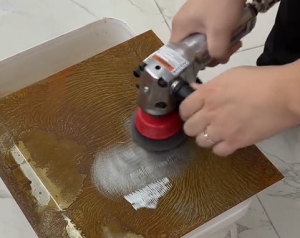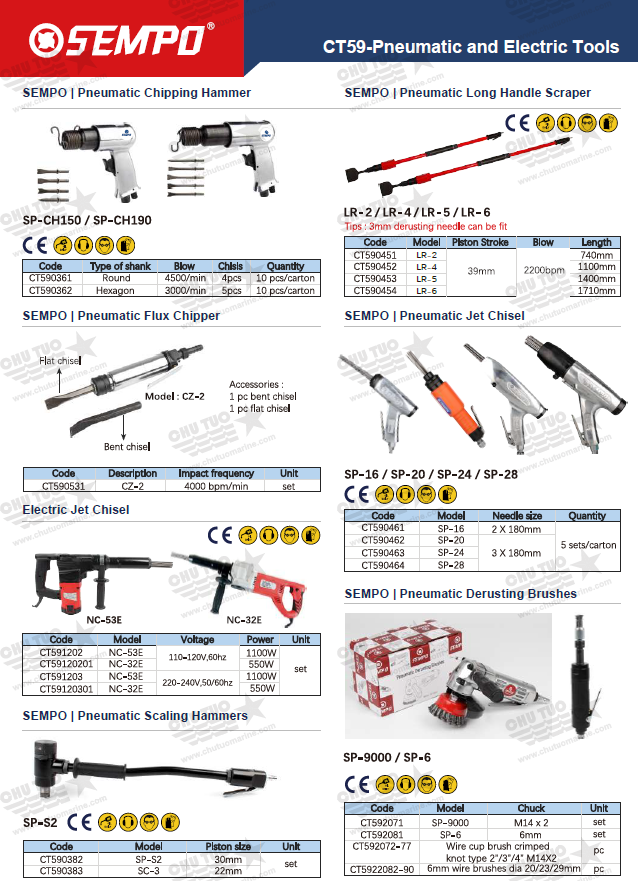Instrumenta pneumatica modum quo rubiginem removemus et superficies praeparamus mutaverunt. Hoc praecipue verum est in industriis maritimis.Peniculus pneumaticus ad rubiginem detrahendam, sicut SP-9000 a ChutuoMarine, instrumentum validum est. Cito rubiginem, picturam, et alias sordes e superficiebus metallicis removet. Attamen, usus huius instrumenti improprius ad inefficientias, pericula salutis, et detritionem praematuram ducere potest. Hic sunt septem errores communes vitandi cum peniculis pneumaticis rubiginem removentibus. Hoc te adiuvabit ut optimam efficaciam consequaris et diutius ex investimento tuo dures.
Preme ut videas pelliculam de usu Penicilli Pneumatici Rubiginem Detrahendi:Quomodo Penicillo Pneumatico Rubiginem Detrahente Utaris et Effectus Eius Usus
1. Neglectio Curae Regularis
Una ex gravissimis partibus usus instrumentorum pneumaticorum est regularis cura. Si penicillum pneumaticum ad rubiginem detrahendam non inspicias et non cures, eius efficaciam minuere et periculum frangendi augere potes.
Solutio:
Inspectiones OrdinariaeAnte quemque usum, penicillum detrimento vel laceratione inspice. Fac ut omnes partes in bono statu sint.
PurgatioPenicillum mundum et a sordibus liberum serva. Purgatio regularis optimam efficaciam praestat et vitam instrumenti extendit.
Peniculum pneumaticum rubiginem detrahens in bona forma servando, securitati prodest et efficaciam auget. Hoc instrumentum fidum facit pro navibus onerariis et negotiatoribus.
2. Usus Pressionis Aeris Incorrectae
Instrumenta pneumatica optime operantur sub certis pressionibus aeris. Usus pressionis aeris nimis altae vel nimis humilis potest ducere ad effectum minus optimum vel etiam laedere instrumentum.
Solutio:
Inspice normas fabricatoris:Semper inspice libellum usoris de optima pressione aeris constituenda. Pro SP-9000, pressionem rectam servare essentiale est ad optimos eventus consequendos.
Monitorium Pressionis:Regulatoribus pressionis utere ad pressionem aeris constantem servandam. Hoc adiuvat ut penicillum pneumaticum tuum bene operetur.
Pressio aeris idonea instrumenta tua melius operari adiuvat. Ea permittit ut officia bene perficiant, damnum vitantes.
3. Protocolla Salutis Neglegere
Salus semper curae esse debet cum instrumentis pneumaticis laboratur. Neglectio praeceptorum salutis ad accidentia et iniurias ducere potest.
Solutio:
Instrumenta Tutelae Personalis (PPE):Semper induere aptas vestes tutelares personales (PPE). Hoc includit vitra ocularia, chirothecas, et larvas cum instrumentis pneumaticis uteris.
Spatium Laboris PurgatumFac ut locus laboris tuus a periculis vacuus sit et ut adstantes procul tuto serventur.
Cura in salute adiuvat ad casus vitandos. Hoc efficit ambitum laboris productiviorem, quod magni momenti est operationibus servitii maritimi.
4. Defectus in Usu Accessionum Rectarum
Usus penicillorum vel instrumentorum impropriorum ad inefficacem rubiginis remotionem et possibilem superficierum laesionem ducere potest. Quaeque instrumenta pneumatica ad specifica genera instrumentorum destinantur.
Solutio:
Utere accessionibus congruentibus:Solum peniculos commendatos pro instrumento pneumatico tuo utere. SP-9000 varietatem generum peniculorum ad usus diversos aptatorum offert.
Penicillorum detritorum substituere:Penicillorum saepe inspectionem fac. Cum deterantur, eos permuta ut rubiginis remotio efficax maneat.
Instrumenta recta efficaciam purgationis augent et superficies protegunt. Hoc adiuvat ad normas industriales implendas.
5. Instrumentum Nimium Laborans
Instrumenta pneumatica ad efficientiam designantur, sed nisi recte adhibeantur, nimium laborare possunt. Usus diuturnus sine intervallis ad nimium calefactionem et praematuram defectum ducere potest.
Solutio:
Pausae fac:Instrumenta tua saepe quiescere sine durante longo usu. Hoc adiuvat vitare nimium calorem et defectum mechanicum.
Spectaculum Efficaciae:Mutationes quaslibet animadverte quae ostendunt instrumentum fortasse nimium in usu esse.
Usum tuum bene modera ut apparatus pneumaticus tuus diutius duret. Hoc adiuvat ut efficacia constans maneat, quod magni momenti est ad operationes commeatus navium.
6. Operatores Non Recte Erudiendo
Usus improprius ob inertiam disciplinae ad errores ducere potest qui salutem et efficaciam laedunt. Necesse est ut omnes operarii in usu instrumentorum pneumaticorum bene erudiantur.
Solutio:
Instructio CompletaOmnibus qui instrumentis pneumaticis operabuntur, diligenter instituendum est. Hoc praecepta salutis, rationes conservationis, et optimas rationes operandi comprehendere debet.
Cursus Regulares Refectionis:Exercitationem recentem serva eam regulariter renovando. Hoc omnibus operatoribus prodest ut de novissimis artibus et mensuris salutis certiores fiant.
Instructio salutem et efficaciam in opere auget. Hoc tempus et opes conservat.
7. Praeparationem Superficiei Omittendo
Antequam peniculis pneumaticis ad rubiginem detrahendam uteris, superficiem rite praeparare necesse est. Hoc omittere purgationem inefficacem et laborem postea additum efficere potest.
Solutio:
Inspectio PrimaSuperficiem inspice antequam opus incipias num pigmentum laxum aut sordes adsint. Obstructiones magnas, quae efficaciam instrumenti pneumatici impedire possint, remove.
Purgatio Superficiei:Primum, superficiem purga. Hoc eam ad penicillum pneumaticum praeparat.
Bona praeparatio superficiei instrumenta pneumatica melius operari adiuvat. Hoc efficaciorem rubiginis remotionem et meliora resultata significat.
Conclusio
Peniculi pneumatici ad rubiginem detrahendam, velut SP-9000 a ChutuoMarine, rubiginem tuam removere possunt. Attamen, errores communes vitare est maximi momenti ad earum efficaciam augendam et salutem conservandam.
Navium venditores, mercatores magnarii, et praebitores servitiorum maritimorum in instrumentis pneumaticis qualitate praestantibus pecuniam collocare debent. Scopa pneumatica ad rubiginem detrahendam instrumentum vitale est ad operationes lenes. Haec instrumenta facta sunt ad condiciones maritimas difficiles tolerandas. Hoc significat te rubiginem celeriter et efficaciter removere posse.
Ready to enhance your rust removal capabilities? Check out the variety of pneumatic tools at ChutuoMarine. They can help meet your operational needs. Email us at sales@chutuomarine.com for details on our products and marine services!
Tempus publicationis: XXII Maii, MMXXXV








